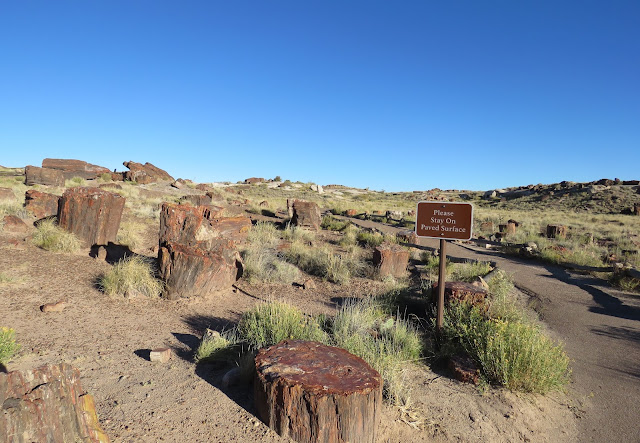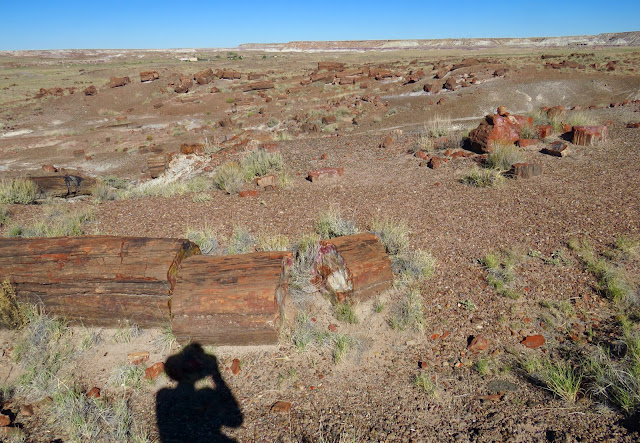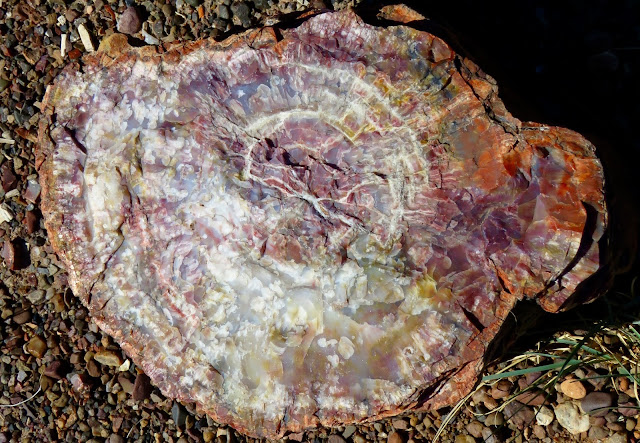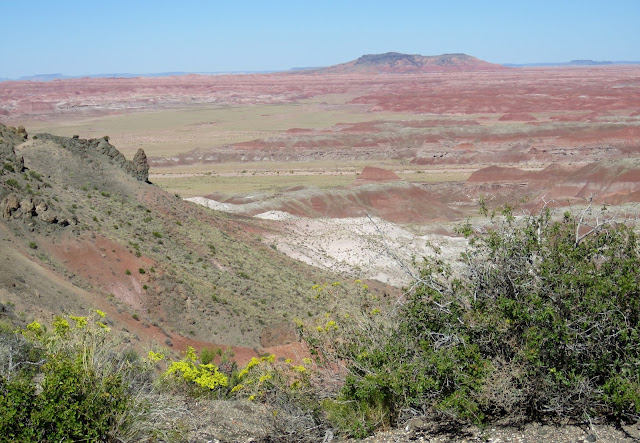I started my tour at the south entrance to Petrified Forest NP. Thistle was with me because dogs are allowed on all the trails in this park. You can tell it is early morning because I still have my sweatshirt on.
Rainbow Forest Visitor Center. I did not watch the 20 minute video because Thistle couldn't go inside the building, but we both walked the Giant Logs Trail behind it.
Some of the largest and most colorful petrified logs in the park are along this trail.
Check out the striped mesa near the trail. The alternating bands represent muddy floodplains deposited through time by river activity.
Thistle poses by "Old Faithful," the giant of the Giant Logs. It measures 35 feet long and weighs about 44 tons.
It is a favorite visitor attraction and photo op.
Do you recognize the visitors in this picture from 1931? (Dr. and Mrs. Albert Einstein)
This log still shows the stump of its taproot. In the background you can see examples of "badlands," similar to South Dakota's NP.
You may notice the logs look like they have been sawed in segments. It was the weight on top of the buried petrified logs that broke them, similar to what would happen if you drop a piece of chalk. Petrified wood is mostly silica-quartz minerals. Silica naturally breaks on a clean angle.
The colors are due to trace minerals that soaked into the wood along with the silica.
Iron minerals provide the bright mustard, orange, reds, ochre, and black. Manganese minerals cause blue, purple, brown, and black.
Thistle looks interested in the view.
Farther along in the park, we hiked two more trails, starting with the Agate House Trail.
Agate House is a 7-room house built by early Puebloans between 1050 and 1300. It was reconstructed in the 1930s using the original petrified wood blocks.
Agate House likely housed a single family, but was part of a much larger community. Hundreds of similar petrified wood structure sites have been found in the park. This is the only one that has been reconstructed.
Colorful stone blocks.
The blocks were held together with a mud mortar.
The reconstruction is not entirely accurate as the original would not have had a window. However, the window makes it easy for us to see inside.
The original entrance was by ladder through a hole in the roof.
Roof construction.
Thistle wanted to see in the window too.
So I picked him up and let him look. That seemed to satisfy him.
I wouldn't mind having a colorful stone cabin like that...very pretty.
The next trail was the Long Logs trail. Site of a Jurassic Era log jam, this area is covered by especially long petrified tree trunks.
Walking through another badlands area.
Some of these trees were over 200 feet tall.
Log jam
More colorful examples...
The last trail we hiked that day was the Crystal Forest Trail, which boasts the most colorful scatter of petrified logs. No comments...just enjoy:
The following pictures were taken from the Jasper Forest Overlook, an area with a high concentration of petrified wood. No trail here.
The last stop of the day was at Agate Bridge. This structure in the parking lot was built in the 1930s as a checking station. It has been used as a shaded picnic shelter, and more recently as restrooms. It is back to being a shade shelter now.
A short trail leads from there to the Agate Bridge, a tree that fell into the river 217 million years ago, became petrified, and became a bridge when water eroded the silt below it.
Water is still eroding the land around it, so it has been fortified below with cement to preserve it awhile. Eventually, erosion will cause it to collapse.
We went home after that because it was getting too hot for more hikes. The next day we re-entered the park from the north entrance, at Painted Desert NP off I-40.
We hiked the Painted Desert Rim trail between Tawa Point and Painted Desert Inn and back.
The Painted Desert extends over 7,500 square miles. This is only a tiny portion of it seen from this trail.
You can just see the Inn on the rim at left. It blends in with the landscape.
These particular mudstone and sandstone rocks are called the Chinle Formation, and were deposited between 227 to 205 million years ago during the Late Triassic Period.
Black basalt, seen in the foreground, forms the rim of the plateau. It was deposited by local volcanoes between 16 and 5 million years ago.
All the colors that you see are caused by iron in the sediments.
View from the trail.
When the sediments are exposed to oxygen, the iron rusts, creating the red, brown, and orange colors.
I've never noticed Thistle so interested in the view.
This is Painted Desert Inn which has been designated a National Historic Landmark. Once a Trading Post, then an Inn, and now a Museum.
Views from the Inn....
There are people hiking down there. Too long a hike for Thistle.
Thistle checking out the view again.
Lower entrance to the Inn/museum. I wish I could have seen the inside, but couldn't with Thistle.
I need to go back here again sometime, because I left much of the park still unseen, and there are lots more trails to be hiked.









































































